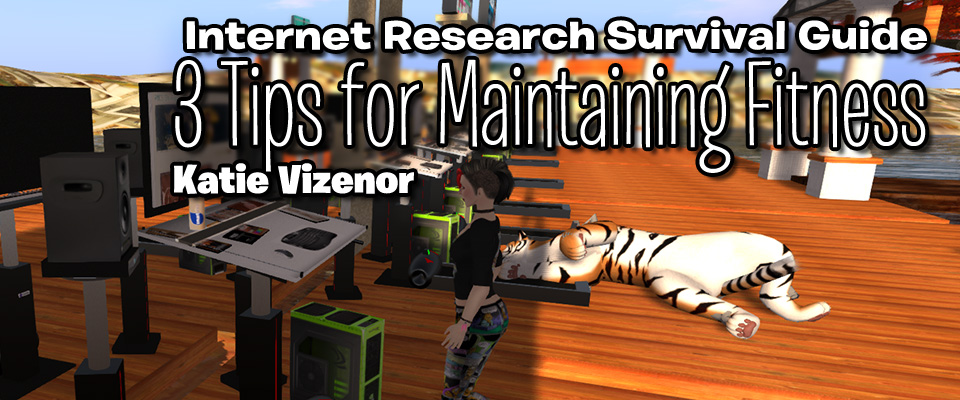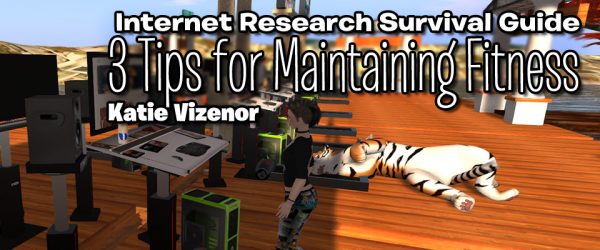Strong Career; Weak Health?
Last month I kicked off the Internet Research Survival Guide Series with an introductory post. That post generated a lot of great ideas. The importance of building an international network of internet scholars. The challenges of using search engines for conducting literature reviews. The narrowing of topics and methods. I hope that we can cover all these topics.
Internet Research, Maintaining Fitness, 3 Tips
My Albatross is Causing Me Back Pain: I love my dissertation. But that doesn’t stop me from sometimes imagining that I am actually stuck in Coleridge’s The Rime of the Ancient Mariner. Except in this case, the bird around my neck has wings made out of printer paper. I spend too much time sitting, hunched over and tense. No surprise, there is a lot of evidence that sitting and a general lack of activity is very bad for your health. It slows your metabolism. It makes you tired. It makes you depressed. It makes you less creative. It weakens you muscles, bones and ligaments. In other words, we need to MOVE MORE.
A Fitness Mindset
For me, it is really easy to get sucked into sitting at my computer all evening without really moving. Or I will put a fitness program off because I don’t have the time, or I can’t get to the gym, or I am not sure I know what I want to do. I found that three strategies really helped me change my habits and maintain a consistent program. So here’s my: Internet Research, Maintaining Fitness, 3 Tips. Or: successful research and good health in the flat panel age.
3 WAY 2 IMPROVE YOUR FITNESS
1. The 15 Minute Rule
If you want to walk an hour a day, don’t start with one hour. Choosing one hour is automatically building in the excuse of not having enough time. Commit to a fail-proof five minutes instead…Take the pressure off and do something small.
— Timothy Ferris, The Four Hour Body
Timothy Ferriss’s 4 Hour Body Book has some good advice on setting reasonable, achievable goals. The idea is that you should set a goal that you feel pretty sure that you can accomplish everyday. If you set an easy goal, you will have no excuse not to do it. And, you will feel really good about yourself which means that you will do it again! I try to follow this rule with my exercise.

Just 15 minutes a day is all I need to fulfill the goal. I can do that anyway I want: I can walk, lift weights, do a quick workout video. Whatever. The magic of this strategy is that pretty soon, you start finding ways to increase that amount. You watch less television. You go to bed early. But it doesn’t start with mapping out a whole life plan. It just begins with a very, very small commitment.
2. It’s not How Much; it’s How Often
I used to workout for an hour and a half in a gym lifting heavy weights guided by a personal trainer. On off days I did some kind of cardio that usually took up that same amount of time. It was awesome. It was intense. It was very time consuming. I have not been able to do that kind of intense program since I started serious work on the dissertation. But, just because I can’t have what is my preferred, perfect program does not stop me from having a program. Instead, I go to a club that is 5 minutes from my house and try to do a 15-30 minute circuit a few days a week.
3. If You Can’t Measure It, You Can’t Improve It.
Keeping track of whatever health and fitness data that you want to improve is always a good idea. If you worry about “stress snacking”, quality of sleep, or activity levels, keep some sort of log to keep track of those activities. Once you have enough data, you can see trends. Maybe you binge snack after you talk to your advisor. Maybe you lose a day of activity after a night out with friends. Luckily for us data geeks, there are lots of good apps and devices that make collecting and analyzing our own behaviors over time much easier. I recently bought a FitBit Flex and log my steps, sleep, mood/productivity and food through the app. I’m already seeing trends in my day. Or, you could just keep an Excel spreadsheet or write it down in a spiral notebook. The point is just to keep a record and look for trends.
I’m hoping to have a future post where I go into a bit more detail about recommendations for specific fitness tools and strategies, workouts, equipment, nutrition, etc.
So, I want to know: How do you Maintain a Fitness Habit while doing your research and writing?

